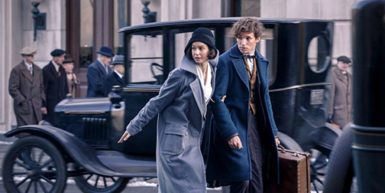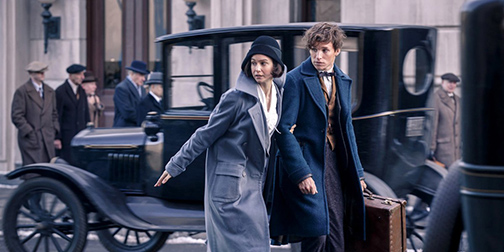LOS ANGELES (Variety.com) – Just when you thought the world of Harry Potter couldn’t get any darker, along comes a bleak-as-soot spin-off that makes the earlier series look like kids’ stuff. Borrowing its title from one of the textbooks Potter studied at Hogwarts School of Witchcraft and Wizardry, “Fantastic Beasts and Where to Find Them” marks the first screenplay written by J.K. Rowling herself. Though the world-renowned novelist had always kept a tight rein on how those adapting her Potter stories went about their task, this assignment gives her the unprecedented ability to address her massive global fanbase directly, while current events have given her something more substantive to say.
The first in an ambitious five-film pentaptych, whose first two installments are being handled by David Yates (the director responsible for the four ultra-bleak blockbusters that wrapped the Potter franchise), . Focusing on a scatterbrained magizoologist named Newt Scamander (Eddie Redmayne), whose personal crusade for the protection of magical creatures will eventually lead him to publish the aforementioned guide, this often heavy-handed political allegory trades present-day England for Prohibition-era New York, at a time when conflicts between magic folk and No-Majs (American for “Muggle”) are brewing — when the humans aren’t fighting world wars among themselves, that is.
It’s 1926, and Scamander arrives at Ellis Island with a bottomless suitcase full of illegal “livestock,” ranging from a mischievous Niffler (a naughty duck-billed marsupial with a nose for treasure) to a giant storm-causing Thunderbird, whose keeper intends to release back into the wild somewhere far from people in Arizona. But the United States is notoriously intolerant when it comes to magic. (Remember the Salem witch trials?) As a precaution, all beasts have been outlawed by MACUSA, the Yankee equivalent of the Ministry of Magic, with stiff penalties for any who disobey.
 Scamander means well, but he’s a bit of a klutz — and not nearly as careful as someone charged with keeping a menagerie of potentially dangerous creatures really ought to be. (If he were cleverer, he probably would have left behind those beasts capable of destroying New York City, such as the atom-bomb-like Obscurus, before traveling.) In his absent-mindedness, however, Scamander accidentally swaps suitcases with Jacob Kowalski (Dan Fogler), a No-Maj factory worker, who swiftly unleashes half a dozen or so of the animals into the streets — animals that have a nasty habit of leaping directly into the lenses of Philippe Rousselot’s 3D cameras.
Scamander means well, but he’s a bit of a klutz — and not nearly as careful as someone charged with keeping a menagerie of potentially dangerous creatures really ought to be. (If he were cleverer, he probably would have left behind those beasts capable of destroying New York City, such as the atom-bomb-like Obscurus, before traveling.) In his absent-mindedness, however, Scamander accidentally swaps suitcases with Jacob Kowalski (Dan Fogler), a No-Maj factory worker, who swiftly unleashes half a dozen or so of the animals into the streets — animals that have a nasty habit of leaping directly into the lenses of Philippe Rousselot’s 3D cameras.
What follows may as well be a high-end, period-themed upgrade to the popular Pokemon GO iPhone game, as Scamander plays a freckle-faced, tweed-jacketed version of Ash Ketchum, scrambling to track down and recapture the escaped creatures before things get really out of hand. Things first spin out of control in an unusually complicated scene at the bank, where Rowling and Yates spin so many layers of surveillance — ex-auror Tina Goldstein (Katherine Waterston) spies on Scamander, who is following Kowalski, who in turn is being watched by a suspicious bank manager — that it starts to feel like trying to follow a piece of fruit as it passes through a blender.
Maintaining Yates as director lends a consistency to the project, and yet, it would have been refreshing to get a completely new take on Rowling’s world with this series, especially considering how murky and self-serious they got in the final chapters. Still, Yates knows this world as well as anyone, and he excels at finding visual solutions for challenging ideas (whether it’s how a witch might cook without an oven or a creature who either grows or shrinks to the available space). With all its ties to Harry Potter arcana, “Fantastic Beasts” has clearly been designed for the most devoted of Rowling’s fans, and though it may prove confusing to newcomers, the faithful will appreciate the fact the film never talks down to its audience.
Oddly, Rowling’s script gives us practically no information about Scamander’s backstory at this point, whereas Goldstein gets multiple flashbacks over the course of the film. That’s probably because Rowling, whose world-building skills are rivaled only by George Lucas, appears to be primarily concerned with plot at this point, and Goldstein’s memories serve the story, while this two-plus-hour-plus pilot evidently doesn’t leaves much room for the sort of character detail we’d all like to get about Scamander (whom Redmayne plays with stooped shoulders and a slightly bow-legged walk, easily winning sympathy for someone whose every judgment seems to endanger the fate of his kind).
These are times of intense superstition for No-Majs and wizards alike, and though the latter are progressive in their choice of leader, electing a mixed-race female president named Seraphina Picquery (Carmen Ejogo), they’re largely intolerant of No-Maj Americans — with good reason, as it turns out: There’s a new sect of magic-fearing protesters on the rise, led by a zealot named Mary Lou Barebone (played with Puritanical self-righteousness by Samantha Morton). Outfitted like a character out of “The Crucible,” Barebone steals/adopts children from the magic families she exposes, but doesn’t keep nearly a close enough eye on her kids, leaving room for her deeply troubled “son” Credence (Ezra Miller) to hold private meetings with a powerful — and power-hungry — auror, Percival Graves (Colin Farrell).
Naturally, Graves is hiding one of those elaborate duplicitous agendas that Rowling loves to invent, raising the stakes for her protagonists — Scamander, Kowalski, Goldstein and Tina’s sister, a mind-reading legilimens named Queenie (Alison Sudol, who looks the part of a period-appropriate showgirl) — from merely recapturing all of those fantastic beasts on the loose to preventing Barebone and Graves from exposing America’s magic underworld to the unsuspecting human population. Those are enormous stakes better suited to some of Scamander’s powerful friends back home (like Albus Dumbledore, who may appear in future installments), and judging by the desperate look on Redmayne’s face — reminiscent of a waiter attempting to balance a wobbly, six-foot stack of porcelain dishes — he’s going to need considerable reinforcements before facing off against the series’ new ultra-villain, a powerful dark wizard named Gellert Grindelwald, who shows up just long enough to disappear.
Unsurprisingly, “Fantastic Beasts” amplifies both the strengths and weaknesses of Rowling’s storytelling approach, which unfolds in the episodic style of vintage serials — a cliff-hanger-oriented tactic that works well in novels, where readers might otherwise be tempted to put the book down after each chapter, but feels less elegant on screen, since viewers invariably commit to taking in the entire story in one sitting. And yet, the writer has learned something from the Potter franchise, clearly going out of her way to establish a foundation that can be enriched and expanded upon in future films. One can hardly forget how powerful the revelation of Severus Snape’s backstory was, enriched by having a master plan from the beginning, and here, we can sense the first glimmers of character details that will require several installments to take focus.
And yet, rather than simply promising a greater scope to come, “Fantastic Beasts” takes place in a world far larger than any of the Potter films, by virtue of both its heightened budget and setting, taking place in New York City right under the No-Majs’ noses. It may be cute to obliviate witnesses one at a time, memory-wiping bystanders the way the Men in Black did after any alien sighting, but to do so to a city at large smacks of cheating.
Though Rowling takes the opportunity to introduce a few tolerance-oriented messages, one can’t help but question the limits of the allegory: In the real world, bigots don’t have a real reason to hate members of other races and religions, whereas wizards — however much we love them — pose a very real threat to normal people (grisly Obscurus attacks result in at least two deaths, and the destruction of large swaths of New York).
It’s the same logical flaw that operates in both the Avengers and X-Men franchises, and Rowling doesn’t have much to add … yet. But considering that Queenie and Kowalski’s romantic subplot is by far the film’s most charming detail, there are clues that Rowling will have more to say on the subject of half-bloods — such as Harry Potter, born to mixed magic-and-Muggle parents — in the very near future.

